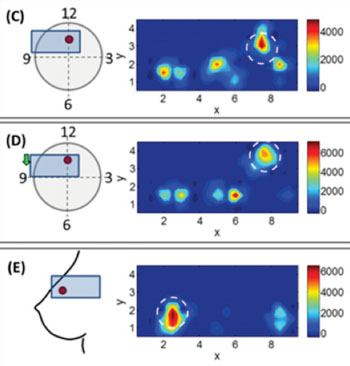Optical Scanner Images Breast Cancer in Vivo
By MedImaging International staff writers
Posted on 02 Nov 2015
Innovative optical scanners show potential for real-time breast cancer screening, according to a new study. Posted on 02 Nov 2015
Researchers at Florida International University (FIU; Miami, USA) and the Sylvester Comprehensive Cancer Center (Miami, FL, USA) have developed a prototype hand-held optical imager with a contourable probe head that performs diffuse nonionizing optical imaging of breast tissue using a near-infrared (NIR) laser diode source to simultaneously illuminate and detect oxyhemoglobin and deoxyhemoglobin concentrations over large surface areas, thus mapping the optical absorption.

Image: Diffuse optical images of a tumor (red) from several probe locations (Photo courtesy of FIU).
The scanner uses 785 nm laser diode sources and intensified charge-coupled device (CCD) camera detectors to generate two-dimensional (2-D) surface maps of total hemoglobin absorption. The subjects lay in supine position, and images are collected at various locations on both the ipsilateral (tumor-containing) and contralateral (non-tumor-containing) breasts. The 2-D surface maps of optical absorption show regions of higher intensity at the tumor location, due to an increased hemoglobin concentration, indicative of an enlarged vasculature and higher blood content due to the presence of the tumor.
In a study to examine the in vivo capabilities of the optical scanner in detecting breast tumors, five female human subjects (ages 51–74) diagnosed with breast cancer were imaged prior to surgical intervention. The scanner was able to detect the presence of invasive ductal carcinoma in three subjects, and ductal carcinoma in situ and metastatic carcinoma in the two other subjects, confirming its potential for imaging human breast cancer. The study describing the device was published on October 23, 2015, in Biomedical Physics & Engineering Express.
“The optical analysis developed offers several benefits over mammography, with no ionizing radiation dose and fewer issues imaging dense tissues,” said senior author Anuradha Godavarty, PhD, of the FIU Optical Imaging Laboratory. “Eventually, we hope that physicians will be able to use this for real-time imaging of breast tissues as part of regular visits by the patients. We're currently working on the mathematical tools required to process the images and produce 3D tomographic images, in order to determine tumor size and depth.”
Related Links:
Florida International University
Sylvester Comprehensive Cancer Center














